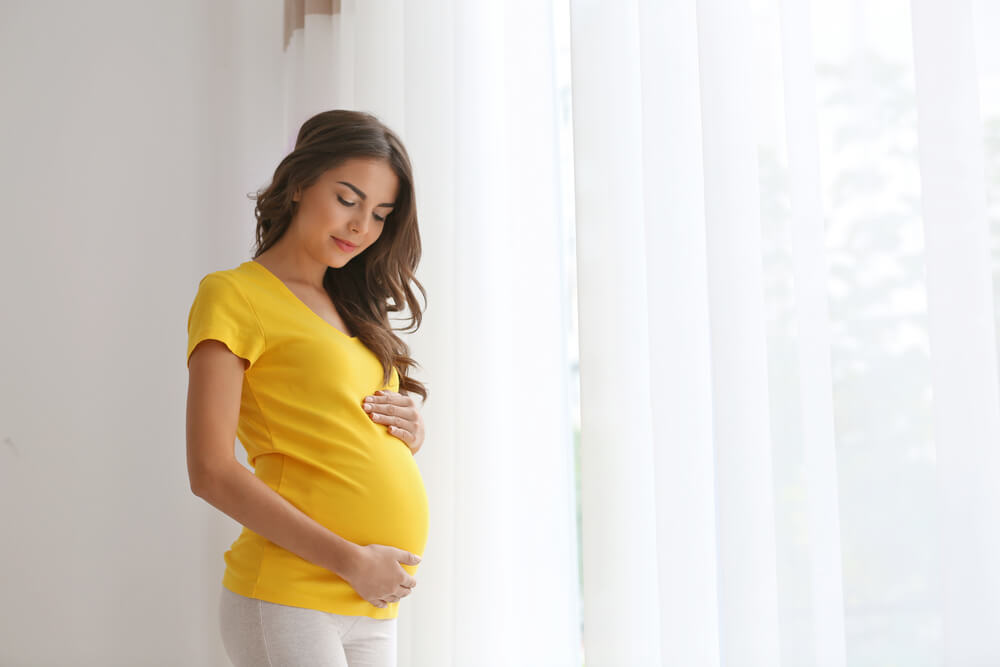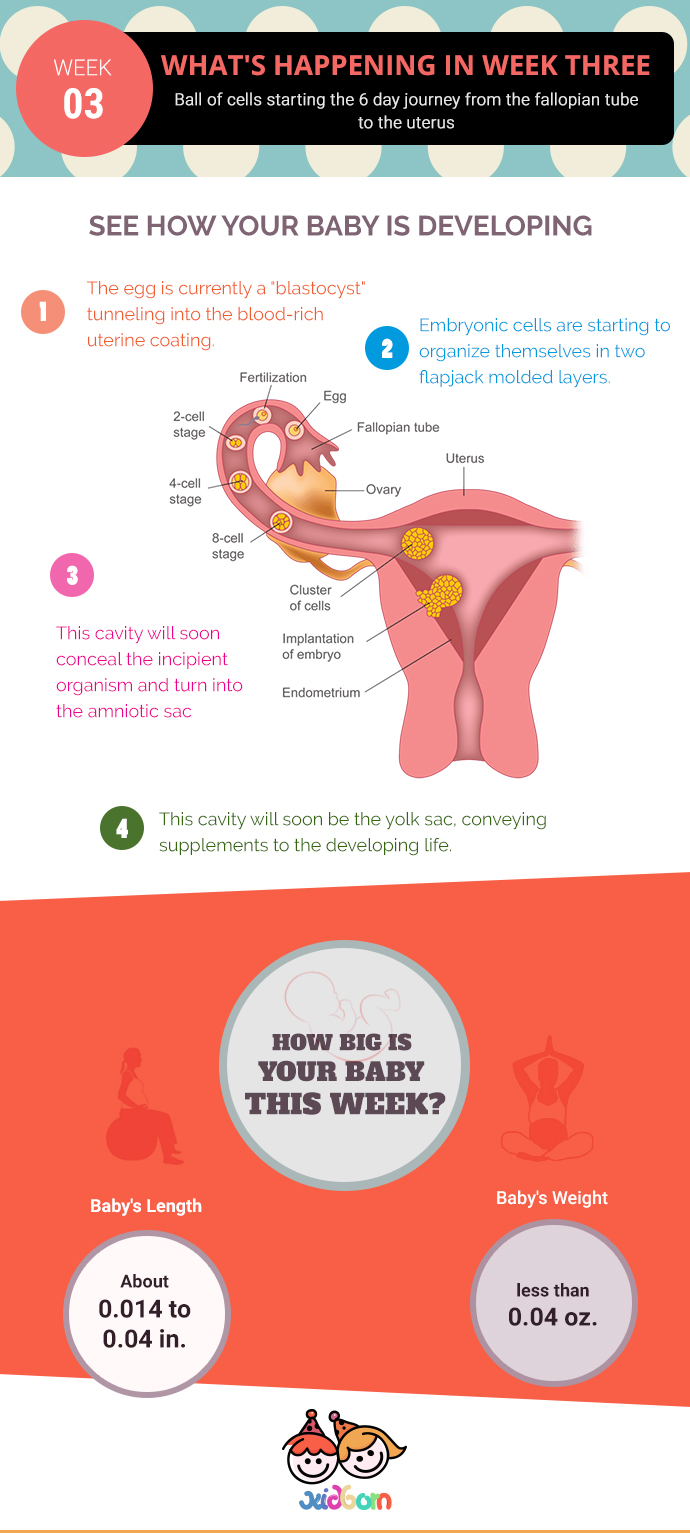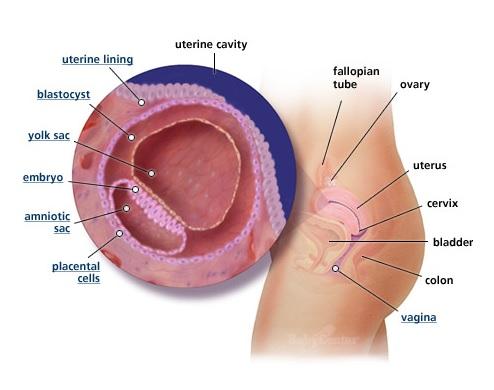
The ball of cells begins the six-day journey from the fallopian tube to the uterus. So what exactly happens to your baby in week three?
A blastocyst is a technical term given by the scientists to denote the ball of cells which is formed by the joining your partner’s sperm and your egg at the moment of conception. It will now start its six-day journey from the fallopian tube to the uterus from there it will get attach itself to the wall of the womb, and in nine months’ time, you will have a healthy baby in your arms.
The fertilised egg carries 46 chromosomes with 23 from you and 23 from your partner. You are one who provides the X chromosome, whereas you partner will be contributing an X or Y chromosome. If it is an XX and you’ll be having a girl, and if it is an XY you’ll have a small boy in 9 months’ time!
Fertilisation happens in one of the fallopian tubes and the cell division will start at a breakneck speed.
As and when the tunnelling sperm penetrates the egg, the egg shuts down, and will not allow any more sperm. Two sets of cell nuclei join inside the egg called as a zygote which assigns the gender, eye and even hair colour of your baby. Additionally, it will also give more than 200 other genetically defined characteristics.

An important meeting took place inside you, where a single sperm got penetrated through the solid outer membrane to your egg and fertilised it. Many days later, the fertilised egg landed in the uterus and started tunnelling into the lining.
Your little one will now consist of several hundred cells that will be doubling madly. The part of it that will grow into the placenta must have started producing the pregnancy hormone called as Human Chronic Gonadotropin or the hCG, which indicates your ovaries to stop delivering eggs and triggers enhanced production of oestrogen and progesterone. These hormones hold your uterus from shedding its lining – and its tiny passenger – and incite the growth of the placenta.
In the meantime, the amniotic fluid will be collected around the ball of cells in the cavity that will form the amniotic sac. This fluid will help in cushioning your baby in the coming weeks and months.
As of now, your little blastocyst is getting oxygen and nutrients (and also discards waste) via primitive circulation system formed of little tunnels that connect the growing baby to the blood vessels in your uterine wall. The placenta won’t be grown enough to take up this duty until the completion of next week.
How do you calculate your due date? It is estimated from the first day of your previous menstrual period. Conception occurs around two weeks from this day, and that’s when you’re actually considered pregnant. In around 40 weeks time your baby will grow from the size of a tiny seed to the size of a watermelon.

Amniotic sac: Amniotic fluid is starting to collect in this cavity, which will soon cover the embryo and form the amniotic sac.
Blastocyst: The baby-in-the-making stage is a small ball of numerous hundred rapidly multiplying cells. The ball is known as a blastocyst.
Embryo: The cells that will form the embryo are starting to organise themselves in two round and flat layers.
Placental cells: These cells will shortly form the placenta. As of now, they’re producing hCG, which is the hormone that converts a pregnancy test positive.
Uterine lining: The blastocyst has begun tunnelling into the blood-rich uterine lining.
Vagina: You may find a bit of spotting by the completion of this week, probably produced by the blastocyst tunnelling into the blood-rich uterine lining.
Yolk sac: This cavity will shortly be the yolk sac, which provides your baby’s red blood cells and carries nutrients until the placenta is set to take over.
By the end of this week, you may be able to find a positive result when you carry out a home pregnancy test. However, if the result is negative, you don’t have to come to the conclusion that you’re not pregnant. It must be probably because you tested too early. (Tests are more probably to give a correct result if you wait some days to perhaps a week after you miss your period. Hold on for a few days, and if you still haven’t got your period, then you need to test again. If another week or more passes by and you still haven’t got your period or even a positive result, then you need to make an appointment to check with your doctor or midwife.
Make sure that you’re taking much care of your baby. Now, before you began trying to conceive, :
You must quit smoking.
Alcohol is also a big ‘No No’.
Avoid the drugs: the illegal, the legal, and those that are labelled as “herbal supplements,” and some of those that come as skin creams (such as acne medication) and also in beverages (such as caffeine).
Quickly notify your care provider regarding any prescription or other medications you presently take or were taking during the time you conceived.
Avoid having large amounts of vitamins: an over-the-counter prenatal or perhaps even daily chewable (like a Flintstone) is sufficient and is suggested for all women who are attempting to conceive or who could possibly be pregnant.
If you have any sort of medical appointment with a dentist or a doctor, notify them that you might be pregnant.
Have around five servings of different fruits and vegetables every day.
Hydrate yourself. Drink lots of water.
It is the most powerful creation to have life growing inside of you.There is no bigger gift